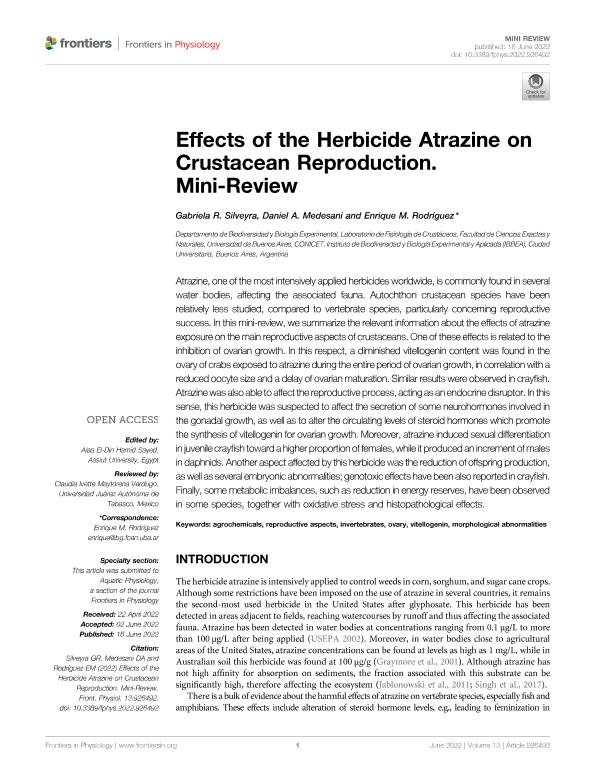Mostrar el registro sencillo del ítem
dc.contributor.author
Silveyra, Gabriela Romina

dc.contributor.author
Medesani, Daniel Alberto

dc.contributor.author
Rodriguez, Enrique Marcelo

dc.date.available
2023-09-28T17:57:50Z
dc.date.issued
2022-06
dc.identifier.citation
Silveyra, Gabriela Romina; Medesani, Daniel Alberto; Rodriguez, Enrique Marcelo; Effects of the Herbicide Atrazine on Crustacean Reproduction: Mini-Review; Frontiers Media; Frontiers in Physiology; 13; 6-2022; 1-5
dc.identifier.issn
1664-042X
dc.identifier.uri
http://hdl.handle.net/11336/213475
dc.description.abstract
Atrazine, one of the most intensively applied herbicides worldwide, is commonly found in several water bodies, affecting the associated fauna. Autochthon crustacean species have been relatively less studied, compared to vertebrate species, particularly concerning reproductive success. In this mini-review, we summarize the relevant information about the effects of atrazine exposure on the main reproductive aspects of crustaceans. One of these effects is related to the inhibition of ovarian growth. In this respect, a diminished vitellogenin content was found in the ovary of crabs exposed to atrazine during the entire period of ovarian growth, in correlation with a reduced oocyte size and a delay of ovarian maturation. Similar results were observed in crayfish. Atrazine was also able to affect the reproductive process, acting as an endocrine disruptor. In this sense, this herbicide was suspected to affect the secretion of some neurohormones involved in the gonadal growth, as well as to alter the circulating levels of steroid hormones which promote the synthesis of vitellogenin for ovarian growth. Moreover, atrazine induced sexual differentiation in juvenile crayfish toward a higher proportion of females, while it produced an increment of males in daphnids. Another aspect affected by this herbicide was the reduction of offspring production, as well as several embryonic abnormalities; genotoxic effects have been also reported in crayfish. Finally, some metabolic imbalances, such as reduction in energy reserves, have been observed in some species, together with oxidative stress and histopathological effects.
dc.format
application/pdf
dc.language.iso
eng
dc.publisher
Frontiers Media

dc.rights
info:eu-repo/semantics/openAccess
dc.rights.uri
https://creativecommons.org/licenses/by/2.5/ar/
dc.subject
AGROCHEMICALS
dc.subject
INVERTEBRATES
dc.subject
MORPHOLOGICAL ABNORMALITIES
dc.subject
OVARY
dc.subject
REPRODUCTIVE ASPECTS
dc.subject
VITELLOGENIN
dc.subject.classification
Otros Tópicos Biológicos

dc.subject.classification
Ciencias Biológicas

dc.subject.classification
CIENCIAS NATURALES Y EXACTAS

dc.title
Effects of the Herbicide Atrazine on Crustacean Reproduction: Mini-Review
dc.type
info:eu-repo/semantics/article
dc.type
info:ar-repo/semantics/artículo
dc.type
info:eu-repo/semantics/publishedVersion
dc.date.updated
2023-07-06T22:41:56Z
dc.journal.volume
13
dc.journal.pagination
1-5
dc.journal.pais
Suiza

dc.journal.ciudad
Lausana
dc.description.fil
Fil: Silveyra, Gabriela Romina. Consejo Nacional de Investigaciones Científicas y Técnicas. Oficina de Coordinación Administrativa Ciudad Universitaria. Instituto de Biodiversidad y Biología Experimental y Aplicada. Universidad de Buenos Aires. Facultad de Ciencias Exactas y Naturales. Instituto de Biodiversidad y Biología Experimental y Aplicada; Argentina
dc.description.fil
Fil: Medesani, Daniel Alberto. Consejo Nacional de Investigaciones Científicas y Técnicas. Oficina de Coordinación Administrativa Ciudad Universitaria. Instituto de Biodiversidad y Biología Experimental y Aplicada. Universidad de Buenos Aires. Facultad de Ciencias Exactas y Naturales. Instituto de Biodiversidad y Biología Experimental y Aplicada; Argentina
dc.description.fil
Fil: Rodriguez, Enrique Marcelo. Consejo Nacional de Investigaciones Científicas y Técnicas. Oficina de Coordinación Administrativa Ciudad Universitaria. Instituto de Biodiversidad y Biología Experimental y Aplicada. Universidad de Buenos Aires. Facultad de Ciencias Exactas y Naturales. Instituto de Biodiversidad y Biología Experimental y Aplicada; Argentina
dc.journal.title
Frontiers in Physiology
dc.relation.alternativeid
info:eu-repo/semantics/altIdentifier/url/https://www.frontiersin.org/articles/10.3389/fphys.2022.926492/full
dc.relation.alternativeid
info:eu-repo/semantics/altIdentifier/doi/https://doi.org/10.3389/fphys.2022.926492
Archivos asociados
